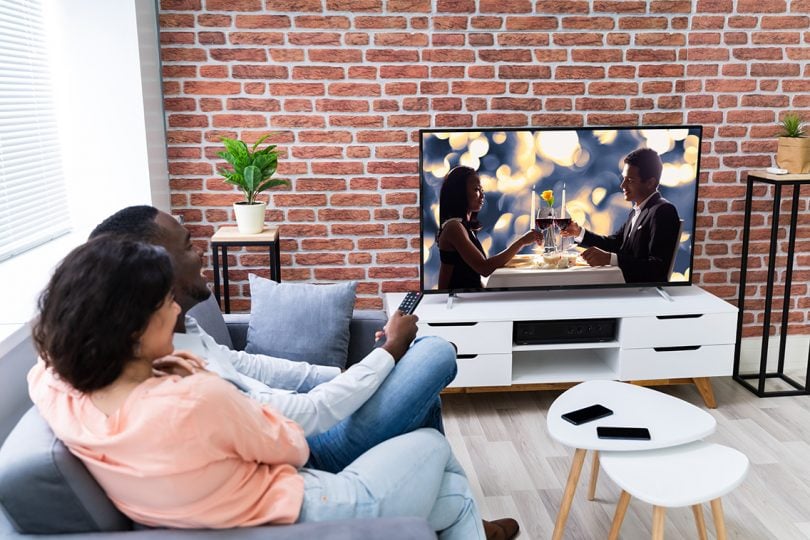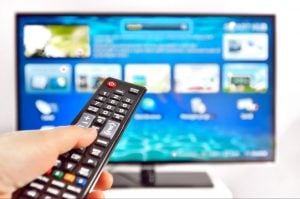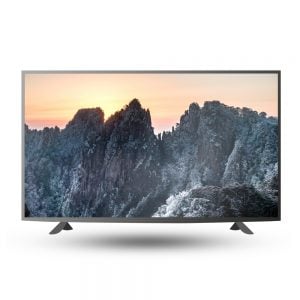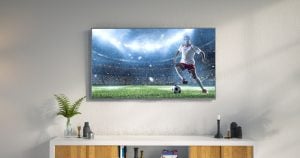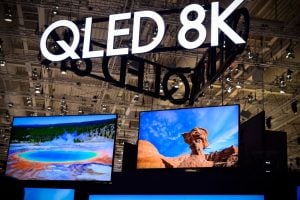TV Screen Types Buying Guide: What’s the Difference?
Recent leaps in TV sizes (98-inch TVs), resolution—we’re looking at you, 8K TVs—and viewing technology have made getting a new TV fun and exciting, but buying the best TV can quickly turn into a frustrating experience when you have no clue what any of the terms, tech jargon, specs, and formats even mean.
The moment you begin reading about mini-led, black levels, contrast ratio, and HDR content, it almost makes you want to quit. We’re not only here to prevent you from that but to educate you on your journey to selecting the right TV.
Long gone are the days of selecting a TV based on screen size alone, so we’ve put together a TV buying guide for you to reference as you’re shopping for TVs, explaining the different types of TV screens including:
- LCD
- LED
- Plasma
- QLED
- OLED
- 4K UHD
But first, let’s talk about Smart TVs. Smart TVs are available in all the screen types listed above. “Smart” refers to the TV’s connectivity and app functionality rather than its screen or display quality.
What is a Smart TV — and Do You Need One?
A Smart TV is equipped with internet connectivity to support interactive apps and functions. Instead of plugging in a streaming device, you can simply navigate to the built-in (or downloaded) streaming apps with the TV’s remote. Streaming services such as Netflix, Roku TV, YouTube, Hulu, Disney+, Amazon Prime, and Sling TV are all commonly included in Smart TVs. Music streaming apps, like Spotify or Pandora, are also typically included.
Smart TVs also offer wireless connection to other devices, allowing you to stream or read content from your phone or laptop on the big screen. If you use a voice assistant, such as Google Home or Alexa, you can integrate that with a Smart TV for voice control, too.
Of course, you’ll need to connect your Smart TV to your high-speed internet via WiFi (the easiest option) or a LAN cable directly from your router (the more reliable option).
With internet connectivity comes a few risks, but none that should stop you from exploring Smart TVs. Yes, a Smart TV can be hacked — via voice and video functionality or sensitive data such as passwords— so, that may be a turn-off for the privacy-conscious. And, since the streaming device is built-in, you can’t disconnect it and hook it up to a different TV. Some Smart TVs also have limited streaming app availability, so if your favorite isn’t built-in, you would have to add a streaming device to access it — so be sure to check before you buy.
Whether you go with a Smart TV or prefer a standalone streaming device, your next important decision is screen type.
LCD TV Screens
LCD stands for Liquid Crystal Display, a specific flat panel that either allows or blocks the passage of light. The panels are composed of segment blocks filled with liquid crystals. The transparency and color of the blocks can be altered by reducing or increasing electrical currents. To see these colors, you need light — like a fluorescent bulb in older models or a large LED (light-emitting diode) in modern TVs (more on those up next).
The best reasons to select an LCD TV are the high resolution, high definition, superb color, energy efficiency, better contrast, and the lack of screen burn-in after prolonged use. Downsides include limited viewing angles and brightness. Because of these pros and cons, LCD TVs are great for your living room, where you sit directly in front of it, but not the best choice when you need it to be viewed from multiple perspectives. For example, if you’re planning to use gaming consoles or, even more so, if you invite other gamers.
LCD TVs are the most affordable option, so if price is your top concern, start your shopping with this type.
Sound like the right choice for you? Shop FlexShopper’s lease-to-own¹ LCD TVs.
LED TV Screens
Although many people think that LED TVs are a new format of TV, they’ve been around for some time. They’re simply an updated version of the LCD generation. Both LED and LCD TVs use the same technology. Instead of being illuminated by a fluorescent bulb like an LCD screen, an LED screen is lit by several LEDs (light-emitting diodes). These TVs are more narrow and efficient due to the LEDs being smaller in size and less energy-intensive.
Viewing angle and display of black images and brightness are all improved compared to their LCD predecessors, making them a versatile and robust option. Users may have some difficulty mounting an LED TV to the wall, but otherwise, they’re a well-rounded screen type without the inherent problems of older technology.
LED TVs can be divided into two subcategories: edge-lit LEDs and direct back-lit LEDs.
Edge-lit LED TVs
This is exactly what the name implies: a TV screen lit from the outer edges. Edge-lit LEDs reflect light to the center of the monitor. They’re the lightest and thinnest LED TV types available since there are fewer lights in the middle of the screen. This helps with dimming levels and color accuracy while improving efficiency across the board.
But, while edge-lit LED TVs tend to be cheaper, the picture quality just isn’t as good or consistent as…
Direct-lit LED TVs
Direct-lit displays are backlit by LEDs located directly behind the LED screen. This allows for focused lighting areas, which means specific cells of darkness and brightness can be more effectively displayed. As a result, viewers get better color accuracy, brightness, contrast, and dimming levels.
As you might have guessed, the downside is that these are more expensive and thicker than edge-lit models.
With either edge- or direct-lit screens, higher-end models feature local dimming, which produces richer colors and avoids the washing out of deep blacks.
From your basic LED TV to the advanced direct-lit models with local dimming, you’ll find a wide range of sizes and price points available. If you’re into high-def movies, live sports, or gaming, an LED TV is a great step up from LCD.
Consider one of FlexShopper’s lease-to-own¹ LED or LCD TV options and see what all the buzz is about.
Plasma TV Screens
Plasma TV screens are quite interesting. A mixture of gasses nestled between two sheets of glass composes the screen itself. The gasses are injected and sealed in plasma form during manufacturing, providing the moniker, “plasma TV.” The gasses react, causing illumination in the pixels on the screen as they become electrically charged.
You’ll typically find plasma screens on large TV types, such as those that are 40 inches or larger. While they may be an interesting option for a high-resolution display, they have plenty of disadvantages including problems with screen burn-in, low life, and poor energy efficiency. You also won’t find plasma screen TVs on FlexShopper, as Plasma TV production ended in 2015. We only lease-to-own1 brand-new products, but it’s worth knowing about plasma if you’re cross-shopping used TVs.
If you’re looking for plasma-level picture quality, consider instead…
QLED TV Screens
QLEDs represent the pinnacle of quality in Samsung’s TVs, with some QLED models sporting 8K resolutions and delivering exceptional image quality. QLED stands for quantum dot LED TV. It’s a variation of LED, relying on a backlight. When the light from the LED backlight hits the quantum dots — microscopic molecules within the display — the quantum dots emit different colored lights. Although Samsung uses the term QLED, other TV creators such as Hisense and Vizio also use quantum dots in LCD TVs, so it isn’t proprietary to Samsung.
Beyond killer resolution, there are a few reasons one may choose to go with a QLED TV. To begin, the brightness is about 50 to 100 times brighter than LCDs. Plus, it uses less power than other types of TV displays — for instance, QLED is up to two times more energy-efficient than OLED screens.
QLED also avoids the risk of the dreaded screen burn-in that afflicts so many other types of displays. They do, however, require a backlight just like standard LED screens. That said, blues may look a bit off at times (less saturated) and some QLED screens suffer from light bleed — a slight haze that affects objects in a scene. Ultimately, though, QLED is a clear step up from LED.
If you’re willing to pay a bit more than LED to get exceptional quality, check out FlexShopper’s selection of lease-to-own¹QLED TVs.
OLED TV Screens
For the highest quality of all screen types, look to OLED!
While it does have LED in the name, OLED is very different from an LED TV.
OLED stands for organic light-emitting diode and uses organic materials, such as carbon, to create light when it’s directly supplied by an electrical current. OLED TVs do not need a backlight to illuminate the screen area (unlike LED and QLED). That means OLED TVs can be very thin and even flexible, with some curved models — some can even roll up!
Due to individual areas being lit up directly and not by an external source, the OLED TV’s color and contrast are of better quality than a typical LED. The OLED processes images faster by creating deeper colors and crisp contrast.
As you may have guessed, because of their dedication to high quality and amazing resolution, OLED TVs tend to be more expensive — but that need not be a problem with Flexshopper.
With FlexShopper, you can lease-to-own¹ an OLED TV without the burden of the full cost upfront. Why wait? Get your OLED TV today and experience better resolution than you’ve ever seen before, all in the comfort of your own home.
What About 4K UHD TVs?
You’ll find the term 4K UHD on a variety of TV models, including LED, OLED, and QLED. The key to understanding different types of TVs is remembering that 4K refers to the resolution, while LED, OLED, and QLED refer to the technology used to create the display.
TVs that have 4K resolution eliminate the pixelated view older TVs sometimes display. You’ll see the subject on the screen rather than the individual pixels, enhancing the overall viewing experience.
The type of TV screen (LED, OLED, QLED, etc.) you have influences color, brightness, and viewing angles.
Now that you’ve become an expert on the different types of TV screens, browse our selection of lease-to-own¹ TVs to start building your home entertainment setup today.
After all, every good home entertainment setup starts with a great TV.
Lease-to-Own1 a Brand New TV with FlexShopper
With FlexShopper, you can lease-to-own the brands you love and pay as you go. FlexShopper TVs are a great option for those without the cash or credit needed to purchase a certain model in full, upfront. With more flexible weekly payments, you can enjoy your new TV now and own it in 12 months or less!
Make sure you kit out your full HD TV setup with a booming soundbar, home theater sound system, streaming device, Blu-ray player, plus the furniture and mount you need to complete the experience.
FlexShopper is here to help you put it all within reach. Shop brand-new TVs from the brands you love and make your home the entertainment destination you’ve always wanted it to be!

